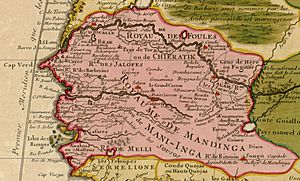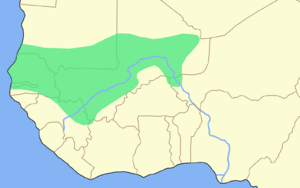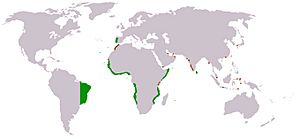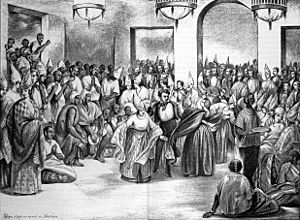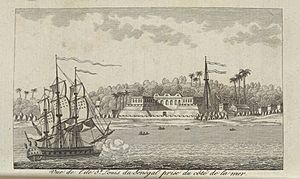History of Senegal facts for kids
The history of Senegal is a long and interesting story, divided into different time periods. It starts with the very first humans, then moves through ancient kingdoms, the arrival of European traders, and finally, the country's independence and modern times.
Contents
Early Humans in Senegal
The very first signs of human life in Senegal have been found in the Falémé River valley in the southeast. Scientists have discovered ancient stone tools there. These tools show that people lived in this area a very long time ago, even during the Paleolithic (Old Stone Age) and Neolithic (New Stone Age) periods.
During the Neolithic period, people in Senegal started to become hunters, fishers, and farmers. They also began making more advanced tools and pottery. Important sites where these discoveries were made include:
- Cape Manuel: Here, tools made from basalt rock were found. These tools suggest that fishermen were active nearby, possibly even building boats.
- Bel-Air: Tools made from flint were found here, along with pottery and a small statue called the Venus Thiaroye.
- Khant: This site in the north is known for tools made from bone and wood.
- Falémé River: In the southeast, many polished stone tools and pottery from this period have been discovered.
Ancient Kingdoms and Empires
Before Europeans arrived, the region of modern Senegal was part of a larger area called Upper Guinea. Historians learn about this time from archaeological digs, old Arabic writings, and stories passed down through generations. These sources suggest that people came to Senegal in waves from the north and east, including the Wolof, Fulani, and Serer groups.

Some of the earliest and most powerful empires in this part of Africa were the Ghana Empire, the Mali Empire, and the Songhai Empire. While the main parts of these empires were in what is now Mali, Senegal was on their edges.
The Ghana Empire was one of the first, likely founded around 1,000 years ago by the Soninke people. They were farmers and traded across the Sahara Desert, exchanging gold, salt, and cloth. Their influence reached the areas between the Senegal and Niger rivers.
A kingdom called Tekrur existed around the same time as Ghana. It was located in what is now Fouta Toro. Tekrur was one of the first places in the region to adopt Islam, even before the year 1040. They traded with Arab merchants, exporting gold and slaves, and importing wool, copper, and pearls. The growth of Arab-Muslim empires led to an increase in the trans-Saharan slave trade.
Two other big kingdoms grew in the 13th and 14th centuries: the Mali Empire and the Jolof Empire. The Mali Empire grew to include much of eastern Senegal. The Jolof Empire was formed in the 14th century by different states like Waalo, Cayor, Baol, Sine, and Saloum joining together. It was more like a group of states working together than an empire built by war. However, the Jolof Empire eventually broke apart around 1550.
As Europeans arrived, the smaller kingdoms in Senegal became more independent from Jolof. They started trading more with the new shipping routes to the Americas, which changed their economies. The Atlantic slave trade grew, with young Africans being taken to the New World in exchange for weapons and goods. This period also saw the increasing influence of Islam and religious leaders called marabouts.
In the Casamance region, different groups like the Baïnounks, Manjaques, and Diola lived along the coast. The inland areas were united under the name Kaabu in the 13th century, mostly by the Mandinka people.
European Traders and Trading Posts
In the mid-15th century, European nations like Portugal, the Netherlands, England, and France began to arrive on the coast of West Africa. They set up trading posts, first on islands and river mouths, then further inland. They traded various goods like wheat, pepper, and ivory. However, the slave trade became a very important part of this new economic system.
Portuguese Explorers
Portuguese explorers, encouraged by Henry the Navigator, sailed down the African coast looking for a sea route to India, and also for gold and slaves.
In 1444, Dinis Dias reached the westernmost point of Africa, which he named Cabo Verde (Cape Vert) because of its green plants. He also found Gorée Island, which he called Ilha de Palma (Island of Palms). The Portuguese didn't settle permanently but used these places for trade. They built a chapel on Gorée in 1481. Portuguese trading posts were also set up in places like Rufisque, Saly, and Joal. They also founded Ziguinchor in the Casamance region in 1645.
The Dutch West India Company
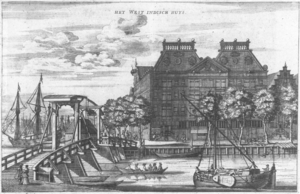
The Dutch, who were becoming a strong sea power, also set up trading posts in West Africa. The Dutch West India Company, formed in 1621, bought Gorée Island in 1627. They built forts and warehouses there. The Dutch called the island Goe-ree or Goede Reede, meaning "good harbor."
The Dutch stayed on Gorée for about 50 years, trading in wax, amber, gold, ivory, and slaves. However, they were often challenged by the Portuguese, French, and English, who also wanted control of the island.
French and British Competition
The "trade" and slave trade became even more intense in the 17th century. France and Britain especially competed for control of Gorée Island and St. Louis. These places changed hands many times between the two countries. For example, in 1763, after the Seven Years' War, Britain returned Gorée to France but gained control of the Senegal River and its trading posts, including St. Louis.
Various French trading companies were created to manage trade in Senegal, but they often faced difficulties. The British also had their own company, the Royal African Company.
In 1783, the Treaty of Versailles returned Senegal to France. The French tried to improve the colony, but smuggling of gum arabic and gold was common.
A Trading Economy and Slavery
Europeans had hoped to find more gold in West Africa. But when plantations in the Americas (like in the Caribbean, Brazil, and the southern United States) needed a lot of cheap labor, West Africa became very important for the slave trade. The Roman Catholic Church did not strongly oppose slavery until the late 17th century.
Some African groups, like the Dyula, specialized in the slave trade. Kingdoms and traders competed, and many became very rich from the triangular trade, which involved shipping slaves from Africa to the Americas, raw materials from the Americas to Europe, and manufactured goods from Europe to Africa. This trade caused a lot of political and military problems in the region.
In Senegal, trading posts were set up in Gorée, St. Louis, Rufisque, Saly, and Joal. Fort St. Joseph, in the upper Senegal River valley, was a key French center for the slave trade in the 18th century.
Over time, a mixed-race society developed in St. Louis and Gorée.
Slavery was abolished by France in 1794, then brought back by Napoleon in 1802. The British Empire abolished slavery in 1833. France finally abolished it for good in 1848.
Modern Colonialism
From the 15th century, European powers fought for control of trade in the area. By 1677, France controlled Gorée Island, which was a major point for the slave trade. In the 1850s, under Governor Louis Faidherbe, the French began to expand their control onto the Senegalese mainland, taking over from local kingdoms.
The Four Communes of Saint-Louis, Dakar, Gorée, and Rufisque were the oldest colonial towns in French West Africa. In 1848, people born in these towns were given the rights of French citizens. However, there were still many barriers, especially for those seen as full-blooded Africans.
Most Africans in these towns were called originaires; they were born in the communes but still followed African or Islamic law. A few Africans who got higher education and gave up their traditional legal protections could become "Évolués" (Evolved) and were granted full French citizenship, including the right to vote. But even they faced discrimination.
In 1916, originaires finally gained full voting rights while keeping their legal protections. Blaise Diagne was the main person who pushed for this change. In 1914, he became the first African elected to the French National Assembly (the French Parliament). From then until Senegal's independence in 1960, the representatives from the Four Communes were always African and played a big role in the fight for independence.
Senegalese Representatives in French Parliament
Here are some of the important people who represented Senegal in the French Parliament:
- Barthélémy Durand Valantin (1848–1850)
- Jean-Baptiste Lafon de Fongauffier (1871–1876)
- Alfred Gasconi (1879–1889)
- François Carpot (1902–1914)
- Blaise Diagne (1914–1934)
- Galandou Diouf (1934–1940)
- Amadou Lamine-Guèye (1945–1951)
- Léopold Sedar Senghor (1945–1959)
- Abbas Guèye (1951–1955)
- Mamadou Dia (1956–1959)
After 1945, the French gradually gave more voting rights to people in their colonies. By 1955, everyone had the right to vote.
Independence
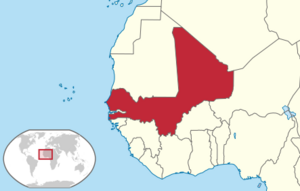
In January 1959, Senegal and French Sudan joined together to form the Mali Federation. This federation became fully independent on June 20, 1960. However, due to political problems, the Federation broke up on August 20, 1960. Senegal and Soudan (which was renamed the Republic of Mali) both declared their independence.
Léopold Senghor, a famous poet and politician, was elected Senegal's first president in August 1960.
In the 1960s and early 1970s, the Portuguese military from neighboring Portuguese Guinea often violated Senegal's borders. Senegal asked the United Nations Security Council for help several times.
President Senghor and Prime Minister Mamadou Dia governed together at first. But in December 1962, their political rivalry led to an attempted coup by Prime Minister Dia. The coup failed peacefully, and Dia was arrested. Senegal then adopted a new constitution that gave the President more power.
Senghor was more open to political opposition than many other African leaders at the time. However, his party, the Senegalese Progressive Union (now the Socialist Party of Senegal), was the only legal party from 1965 to 1975. In 1975, Senghor allowed two opposition parties to form.
In 1980, President Senghor retired from politics and handed power to his chosen successor, Prime Minister Abdou Diouf, in 1981. This was a rare peaceful transfer of power in Africa at that time.
Senegal from 1980 to Today
On February 1, 1982, Senegal and The Gambia formed a confederation called Senegambia. However, the two countries never fully integrated, and the union ended in 1989.
Since 1982, a separatist group in the Casamance region has had occasional clashes with government forces. Senegal has also played a long and active role in international peacekeeping missions.
Abdou Diouf was president from 1981 to 2000, serving four terms. In the 2000 presidential election, he was defeated by opposition leader Abdoulaye Wade in a free and fair election. This was Senegal's second peaceful transfer of power, and the first time power shifted from one political party to another.
On December 30, 2004, President Abdoulaye Wade announced that he would sign a peace treaty with two groups from the Movement of Democratic Forces of Casamance (MFDC) in the Casamance region. This was meant to end West Africa's longest civil conflict. While the peace treaty seemed to hold for a while, some refugees began to flee again in early 2007 due to the presence of Senegalese troops.
In the 2012 election, Abdoulaye Wade accepted his defeat to Macky Sall. In February 2019, Macky Sall was re-elected for a second term. The length of the presidential term was also changed from seven years to five.
See also
 In Spanish: Historia de Senegal para niños
In Spanish: Historia de Senegal para niños
- Dakar history and timeline
- Four Communes
- History of Africa
- History of West Africa
- Politics of Senegal
- President of Senegal
- Prime Minister of Senegal
- Saint-Louis history and timeline
Images for kids


